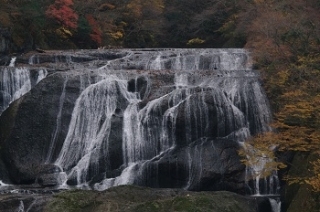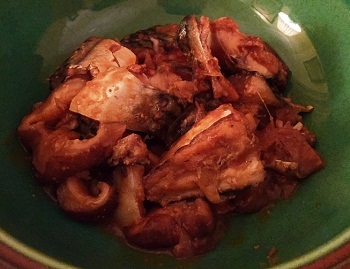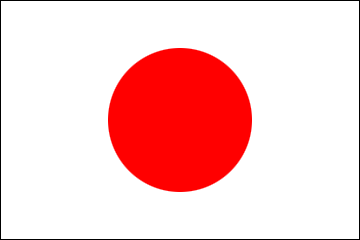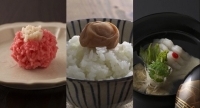Japanese Kitchen
2020/12/18
In the latest edition of our Japanese Kitchen series, we visit Ibaraki Prefecture, just north of Chiba Prefecture which we visited for our last recipe. Especially known for producing fermented soybeans natto, it is mainly an agricultural prefecture, producing food crops that are used throughout the country.
Saba miso ni (Simmered mackerel in miso sauce)
by Tomoko Yoshihiro
originally published in February 2015
originally published in February 2015
 Fukuroda waterfall (photo copyright JNTO)
Fukuroda waterfall (photo copyright JNTO)
I see that a wide range of prefectures were covered in the Japanese Kitchen series. However, one that hasn't yet been visited is Ibaraki, where I spent most of my childhood and teenage years. Ibaraki occupies the central area of the Japan archipelago, a rural area about an hour's car ride from Tokyo.
Ibaraki is abundant in natural beauty. It has Mount Tsukuba, which looks like a mini-Mount Fuji but is much easier to tackle for families with small children for a weekend outing (my first-ever climb was when I was 5 years old). Fukuroda waterfall is amazing to see especially in the winter, when the whole waterfall completely freezes up. The prefecture also has a very long coastline, a vast stretch of almost 200km, and you can enjoy the beaches and good seafood. One of the hidden cultural gems that I highly recommend would be Kasama city. Nichido Museum of Art houses a wide range of Impressionist paintings, works by renowned Japanese artists, and a unique collection of famous artists' palettes on display. The city is also home to Kasama-yaki porcelain - tableware that are very artistic yet unassuming, cherishing the colours of natural earth and clay, finding aesthetics in the daily use of those tableware.
Agriculture and fisheries are very important industries for Ibaraki, and the prefecture has been the largest source of agricultural produce for the Tokyo Central Wholesale Market for the last 11 years running. The prefecture boasts the largest output in Japan of products such as melon, sweet potatoes, mackerel, and prawns, amongst others. Famous local delicacies include angler-fish hotpot, which you can enjoy in the winter, and natto (fermented soy beans), which goes great with cooked white rice.
Personally, I love tofu, miso, and pretty much anything and everything that comes from the sea - but I often find that cooking tempura and yakitori for my British friends is the easiest way to spark their interest in Japanese home-cooking. However, the dish that I'd like to introduce combines two of my favourite things - miso and mackerel. Although not exactly an Ibaraki delicacy, the dish could be said to be a bit like Ibaraki itself. It may not look particularly flattering or exciting at first glance, but you will find that it actually tastes wonderful. It is also not that hard to find the necessary ingredients in British supermarkets, so give it a try!
Ibaraki is abundant in natural beauty. It has Mount Tsukuba, which looks like a mini-Mount Fuji but is much easier to tackle for families with small children for a weekend outing (my first-ever climb was when I was 5 years old). Fukuroda waterfall is amazing to see especially in the winter, when the whole waterfall completely freezes up. The prefecture also has a very long coastline, a vast stretch of almost 200km, and you can enjoy the beaches and good seafood. One of the hidden cultural gems that I highly recommend would be Kasama city. Nichido Museum of Art houses a wide range of Impressionist paintings, works by renowned Japanese artists, and a unique collection of famous artists' palettes on display. The city is also home to Kasama-yaki porcelain - tableware that are very artistic yet unassuming, cherishing the colours of natural earth and clay, finding aesthetics in the daily use of those tableware.
Agriculture and fisheries are very important industries for Ibaraki, and the prefecture has been the largest source of agricultural produce for the Tokyo Central Wholesale Market for the last 11 years running. The prefecture boasts the largest output in Japan of products such as melon, sweet potatoes, mackerel, and prawns, amongst others. Famous local delicacies include angler-fish hotpot, which you can enjoy in the winter, and natto (fermented soy beans), which goes great with cooked white rice.
Personally, I love tofu, miso, and pretty much anything and everything that comes from the sea - but I often find that cooking tempura and yakitori for my British friends is the easiest way to spark their interest in Japanese home-cooking. However, the dish that I'd like to introduce combines two of my favourite things - miso and mackerel. Although not exactly an Ibaraki delicacy, the dish could be said to be a bit like Ibaraki itself. It may not look particularly flattering or exciting at first glance, but you will find that it actually tastes wonderful. It is also not that hard to find the necessary ingredients in British supermarkets, so give it a try!
Saba miso ni recipe
Ingredients
*Can replaced with fresh shiitake mushrooms or simply omitted
 Instructions
Instructions
1. Wash the salted mackerel fillets with water, and remove any excess water with a paper towel. Chop the filets into appropriate sized pieces (the taste is better if the pieces are not too small).
2. Place the ginger, mackerel and konnyaku into a saucepan and add the dashi (or water) little by little until mixed well (about 200 cc should be enough). Add the sugar and mirin and heat over a high temperature.
3. Once the mixture boils, reduce the heat and cover with an otoshibuta or dropped lid (or cover the fish with aluminium foil with a few holes poked in it). Simmer for 10 minutes.
4. Melt the miso paste into the broth, and heat over a medium temperature (taking care not to burn the mixture).
- 2 filets of mackerel (prepare by rubbing the salt over both sides to remove the smell)
- 1 block (6-8mm) konnyaku (devils tongue), cut into thick pieces and boiled*
- 1 thumb-sized piece of ginger thinly sliced
- 200 cc dashi (or water – in which case add a little more sugar, mirin and miso)
- 2 tablespoons sugar
- 2 tablespoons mirin
- 2 tablespoons miso
*Can replaced with fresh shiitake mushrooms or simply omitted
 Instructions
Instructions1. Wash the salted mackerel fillets with water, and remove any excess water with a paper towel. Chop the filets into appropriate sized pieces (the taste is better if the pieces are not too small).
2. Place the ginger, mackerel and konnyaku into a saucepan and add the dashi (or water) little by little until mixed well (about 200 cc should be enough). Add the sugar and mirin and heat over a high temperature.
3. Once the mixture boils, reduce the heat and cover with an otoshibuta or dropped lid (or cover the fish with aluminium foil with a few holes poked in it). Simmer for 10 minutes.
4. Melt the miso paste into the broth, and heat over a medium temperature (taking care not to burn the mixture).

